
The Basics:
- For ages 6 and up (publisher suggests 8+)
- For 2 to 6 players
- Approximately 15 minutes to complete
Geek Skills:
- Active Listening & Communication
- Counting & Math
- Logical & Critical Decision Making
- Reading
- Hand/Eye Coordination & Dexterity
- Memorization & Pattern/Color Matching
- Strategy & Tactics
- Risk vs. Reward
- Visuospatial Skills
- Hand/Resource Management
- Bluffing and Misdirection
- Auctioning, Bidding, & Trading
Learning Curve:
- Child – Easy
- Adult – Easy
Theme & Narrative:
- 8 games you can take anywhere
Endorsements:
- Gamer Geek approved!
- Parent Geek approved!
- Child Geek approved!
Overview
The earliest card game that somewhat resembles today’s deck of cards is Karnöffel, which was played in the 15th century. Since them, cards have found their way into many different games. Cards can be used as markers, values, and even monsters. But the shape of the card has changed little. In this pack of cards, the complete game is contained in a small box no bigger than a package of gum. Chew on that for a moment.
Pack O Games (Set 1), is a collection of 8 games designed by Chris Handy and published by Perplext. Each game comes in a box that is roughly the same size as a package of gum. Each game consists of cards and have a different theme, as well as game play. The cards are thick and as durable as your standard playing card. While the Pack O Games contains all initial 8 games, each game can be purchased individually, as well. When purchased as a set, all 8 games come with a handy carrying case. The carrying case can be purchased separately, however, either with all the games included or empty (which sounds terribly boring).
A Whole Lot of Games
Normally I go into detail about each game, including how it’s set up, played, and won. As this review will cover 8 games, I’m going to reduce the review to a summary of each game, so as to highlight the differences and variety the set contains.
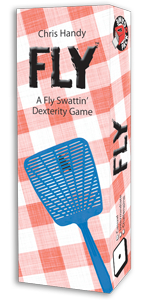 Fly is a dexterity game, where players attempt to swat flies that have landed on their picnic table. Table cards are dealt and create 3 rows of cards, resulting in a checker board pattern that matches a picnic cloth. Two Swatter cards are passed around and shared among the players and a Sky card is inserted in the game box to indicated the minimum height from which a Swatter card can be dropped.
Fly is a dexterity game, where players attempt to swat flies that have landed on their picnic table. Table cards are dealt and create 3 rows of cards, resulting in a checker board pattern that matches a picnic cloth. Two Swatter cards are passed around and shared among the players and a Sky card is inserted in the game box to indicated the minimum height from which a Swatter card can be dropped.
On a player’s turn, they take the Swatter card and drop it above the Table cards in an attempt to cover as many flies as possible. All Table cards with a fly that have been completely covered by the Swatter card are collected by the player. Table cards are moved to fill in any gaps created by moved Table cards.
This continues until the two Table cards that do not have any flies are the only cards left. The players then count their points. Players earn 1 point per fly if they have at least 3 that match a color or symbol. The player with the most points wins the game. If there is a tie, the player with the most flies in total wins.
To learn more about Fly, visit the game’s web page.
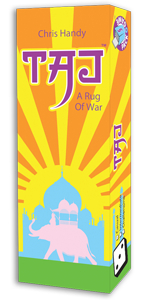 Taj is a game of subtle manipulation and pattern matching. Each player is a rug merchant vying to have their goods prominently displayed in the Taj Mahal. The problem is, there are more rugs and merchants than there is open floor space. The Taj card is placed in the middle of the table and 10 Rug cards are dealt at random underneath it, resulting in only 3 Rug cards currently being under the Taj card (those currently in favor of purchase). Each player is also given a secret card that shows what colors they want to champion and what colors they want to avoid.
Taj is a game of subtle manipulation and pattern matching. Each player is a rug merchant vying to have their goods prominently displayed in the Taj Mahal. The problem is, there are more rugs and merchants than there is open floor space. The Taj card is placed in the middle of the table and 10 Rug cards are dealt at random underneath it, resulting in only 3 Rug cards currently being under the Taj card (those currently in favor of purchase). Each player is also given a secret card that shows what colors they want to champion and what colors they want to avoid.
The game begins with one player proposing two cards that should swap position by slightly pulling them away from the row of Rug cards. Players now vote, but they do so secretly by using their Voting cards that indicate they approve of the swap or they do not approve of the swap. When every player has voted, the cards are revealed.
If the swap met with a majority approval, the Rug cards switch their places and are turned over to indicated that they have been looked at by the Curator. If the swap met with majority disapproval, the player who proposed the swap must remove 1 Rug card from the row that is the furthest from the Taj card. This card is out for the duration of the game. If there is a majority vote (be it approval or disapproval), the cards are moved as before and the Taj card is flipped over and shifted in the row, giving Rug cards new bonuses and focus.
After all the Rug cards have been viewed by the Curator or there are only 5 Rug cards left, each player reveals their secret goal and only those Rug cards underneath the Tag card are looked at. Rugs have 3 colors to score. These are the outer most border, the middle border, and the inner most border. A player’s secret goal will indicate 3 colors, as well, with a bonus or penalty value. Each rug is evaluate using the secret goal scoring and added together to determine the player’s overall score. The player with the most points wins the game.
To learn more about Taj, visit the game’s web page.
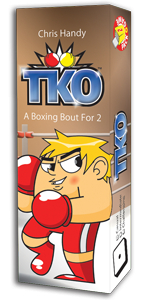 TKO is similar to Rock Scissor Papers, but with a twist. Each player will control 1 boxer that knows 4 different moves (essentially two punches and two blocks). The goal is to score a certain number of points before the opponent by landing blows and blocking punches. Each boxer is not created equal, meaning the players will have certain advantages right from the start that they can attempt to leverage for a victory. Of course the player’s opponent also has an advantage.
TKO is similar to Rock Scissor Papers, but with a twist. Each player will control 1 boxer that knows 4 different moves (essentially two punches and two blocks). The goal is to score a certain number of points before the opponent by landing blows and blocking punches. Each boxer is not created equal, meaning the players will have certain advantages right from the start that they can attempt to leverage for a victory. Of course the player’s opponent also has an advantage.
The game is played out in 2 rounds where each player simultaneously reveals their move. Unblocked punches and blocked hits score points. If players use the same move, neither of the players score a point. Upon scoring a point, the player moves the score marker to the next highest value of the move they just used. The first player to score the maximum number of points in any of their 4 score tracks wins the round.
Players can optionally use an Arrow card to indicate which player has the momentum and advantage. If the player scores a point when they have momentum, they can add their point to any of the 4 score tracks. The moment the player misses a point, however, their momentum is reduced to normal.
The first player to win 2 rounds also wins the title belt.
To learn more about TKO, visit the game’s web page.
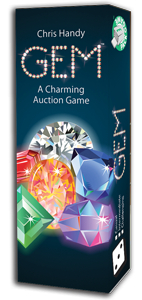 Gem is a tricky game of set collecting and bidding. The goal is to collect Gem cards, but these Gem cards are not only used to create different sets for final scoring, but also for bidding. Money is also provided to the players, which is first used to complete initials bids and then reinvest into their Gem cards. And by “reinvest”, I really mean “refresh”, as the Gem cards go down in value when they are used. Gems with no value are worth nothing at the end of the game and provide no advantage when bidding either.
Gem is a tricky game of set collecting and bidding. The goal is to collect Gem cards, but these Gem cards are not only used to create different sets for final scoring, but also for bidding. Money is also provided to the players, which is first used to complete initials bids and then reinvest into their Gem cards. And by “reinvest”, I really mean “refresh”, as the Gem cards go down in value when they are used. Gems with no value are worth nothing at the end of the game and provide no advantage when bidding either.
The game is played in rounds with a set number of Gem cards being displayed per round. Players go in turn order sequence, announcing their bid, but not the Gem card they want. Players must be able to afford the bid they announce. The highest bidder selects 1 Gem card. Players who win a bid are out, but a player can also skip a bid if they so choose, returning to the bid on a different card.
Once all the players have earned a Gem card, the first portion of the round ends. The second focuses on reinvesting (again, “refreshing”) any cards used in the bid by using money to turn them back to their true value. Then the round ends and all money is returned to its true value as well, ready to be reinvested in the next round.
This continues until all the rounds are played. Players remove any Gem cards that have not been reinvested. These cards will not be scored. Players score 1 point per gem on each Gem card that is fully invested, a bonus 2 points if a player shares the same number of any gem type with another player, and a bonus 3 points if the player has the most of a certain gem. The player with the most points wins the game.
To learn more about Gem, visit the game’s web page.
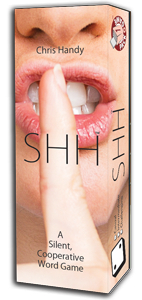 SHH is a cooperative game where players attempt to use as many cards in their hand to score the most points by spelling words. The trick here is that everything is done without speaking. All players share the same Vowel cards and have their own hand of Consonant cards. Players take turns placing cards from their hand or using a Vowel card to continually create a word. Cards are always placed so as to add to a word and always adjacent to the last card played. Cards cannot be moved or removed. Players can also use a Pass card to indicate they don’t have a card worth playing at the moment. This continues until a player calls for a vote.
SHH is a cooperative game where players attempt to use as many cards in their hand to score the most points by spelling words. The trick here is that everything is done without speaking. All players share the same Vowel cards and have their own hand of Consonant cards. Players take turns placing cards from their hand or using a Vowel card to continually create a word. Cards are always placed so as to add to a word and always adjacent to the last card played. Cards cannot be moved or removed. Players can also use a Pass card to indicate they don’t have a card worth playing at the moment. This continues until a player calls for a vote.
Votes are called to score a word, but they are also used to validate the word itself. A valid word is at least 3 cards long, is not an abbreviation, is spelled correctly, and is not a proper noun. Players vote by giving a thumbs-up or thumbs-down signal. If the word is approved and it’s valid, the Consonant cards are removed and place in a row for later scoring and immediate reference. These cards cannot be used again in the game. Vowel cards used are flipped to their other side, indicating they will provide bonus points, and are returned to their original row.
The game continues with a new word and ends when a word is found to be invalid (voted down) or all Consonant cards have been played. Players score 1 point for each Consonant successfully used to create a word and the bonus points earned from Vowel cards. The total number of points is compared to a scale that indicate how well the players did.
To learn more about SHH, visit the game’s web page.
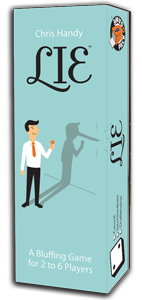 Lie is a bidding, bluffing, and deduction game, all rolled into one. For those familiar with Liar’s Dice, this is the same kind of game, except with cards. The game itself is played in rounds with no set number of rounds per game. However, as the game progresses, it will become increasingly difficult for players to stay in the game.
Lie is a bidding, bluffing, and deduction game, all rolled into one. For those familiar with Liar’s Dice, this is the same kind of game, except with cards. The game itself is played in rounds with no set number of rounds per game. However, as the game progresses, it will become increasingly difficult for players to stay in the game.
Each card has two different images of a dice value. Players start with 5 cards each and decide which values they want to use for the round. Once everyone is set, the initial bid is given in the form of a statement that suggests how many of a certain dice value type are in play between all the players. Better put, a quantity of dice with a specific value. For example, “six fives”, which means the player is suggesting there are at least six cards that have the dice value of five showing.
After the bid the next player must either increase the quantity and provide any dice value or increase the dice value, leaving the quantity as it was previously stated. However, if the player does not feel that the previously stated quantity and dice value is possible, they can challenge the bid. All players then show their selected card values. If the bid was accurate or over, the player who challenged must reduced their current hand size by -1 for the duration of the game. If the challenger wins, the player who stated the incorrect bid loses a card and the player who challenged is the first player for the next round. All the cards are then collected, shuffled and dealt, in which players will have 5 or fewer cards to use. The game ends when there is only 1 player left who can be dealt at least 1 card during a round.
To learn more about Lie, visit the game’s web page.
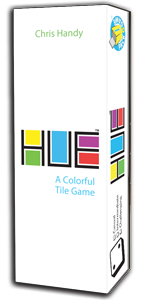 Hue is a color matching game that challenges players to attempt to create large sections of the same color. Or not. It all depends on the player’s scoring card, which is the last card in the player’s hand. Since it’s up to the player to decide which cards to play, the scoring card can be any card in the player’s hand right from the start.
Hue is a color matching game that challenges players to attempt to create large sections of the same color. Or not. It all depends on the player’s scoring card, which is the last card in the player’s hand. Since it’s up to the player to decide which cards to play, the scoring card can be any card in the player’s hand right from the start.
The game begins with each player receiving a Skull and Starting card. These are randomly assigned and hidden from the player’s opponents. The initial pattern is set by drawing Starting cards at random to create a staggered, stair-like shape. Then all the players receive additional cards, with the number of cards dealt based on the number of players.
On a player’s turn, they take one of their cards and play it to the patter. Each card is comprised of 3 sections and at least 1 section of the card must be adjacent (but not diagonal) to a previously played card’s section. New cards can overlay old cards, as well, allowing new shapes and color matching. However, the card colors need not match in order to play a card.
If the Skull card is used, any colors that match the Skull color background and are touching the card are considered out of play when it comes to scoring. Speaking of scoring, when all the players have only 1 card left, the points for each color are counted. Squares are worth 3 points and smaller rectangles are worth 1. These are matched to the player’s Scoring card to determine which colors they count, with the middle section being worth double the points. The player with the most points wins the game.
To learn more about Hue, visit the game’s web page.
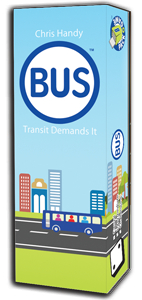 Bus is a game about logistics. Players will take on the role of a bus driver, traveling around the town to pick up riders and dropping them off at their destinations. If this sound pretty h0-hum, just wait.
Bus is a game about logistics. Players will take on the role of a bus driver, traveling around the town to pick up riders and dropping them off at their destinations. If this sound pretty h0-hum, just wait.
Each Passenger card has 2 passengers that match 1 of 6 different bus stops. Player must travel to these spots using the fastest route possible. The number of passengers in the bus will determine the speed of the bus (the number of spaces it can move) and this means that the overall speed will fluctuate during the game. Seldom will any one card have two passengers that want to go to the same spot, meaning players will have to drop some passengers off on one side of the town and the others on the opposite side.
When a player has less than 3 Passenger cards, they can pick up new riders and the exercise starts all over again. There is also a construction spot the players can end their turn on to swap the location of two cards. This spells good news for the player, who can bring bus stops closer together, but might mess up an opponent’s plan. Which isn’t a bad thing. The advanced game challenges players to be on the right side of the street and the ability to rotate cards instead of swapping them.
The game continues until there are no more cards left to be draw and the end game is triggered. Players count the points on their completed Passenger cards. The player with the most points wins the game.
To learn more about Bus, visit the game’s web page.
Final Word
The Child Geeks really liked the game’s packaging. According to one Child Geek, “It looks just like gum!” When it came time to playing the game, the Child Geeks gravitated immediately towards TKO and didn’t want to play anything else. Since there are 8 games, we had enough to split up the Child Geeks into groups and have them play different games. Each one was enjoyed and as the Child Geeks rotated to try new games, the groups discovered that each game was also unique. As one Child Geek put it, “I can’t believe how different these games are. I just played a game about killing flies and now I’m racing round town to drop off people in my bus.” Each Child Geek had their favorite game, but none of the games were disliked. When the votes were in, the Child Geeks approved the entire set.
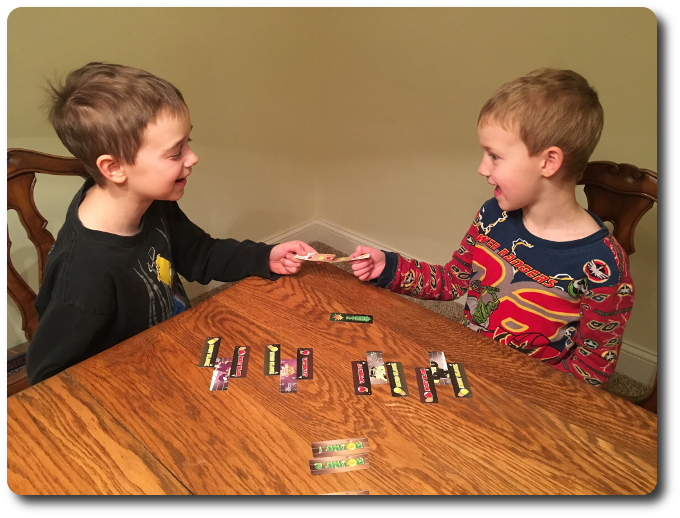
Two Child Geeks playing TKO (the youngest brother pummeled his older brother)
The Parent Geeks didn’t care for the size of the cards at first, fearing that they would be too small and cumbersome to play with. Their fears were put to rest when they discovered that each game took the size of the cards into account and even utilized the cards in different ways. According to one Parent Geek, “I am very impressed with how the game designer has taken a traditional card and improved it. I would prefer a normal sized card, but I don’t think the games would work if the cards were bigger.” Each of the games entertained the Parent Geeks, from hitting flies to moving rugs back and forth. Most of all, they liked that the set contained a game for everyone and it was very small. As one Parent Geek put it, “I’m going to get myself the set and pack it with me when I take the family on road trips or when we take an airplane.” When all the games were over, the Parent Geeks voted to approve Pack O Games.
The Gamer Geeks found Pack O Games to be at first fairly gimmicky. That is, they believed the games, with their smaller cards, were designed to look different and unique, but really weren’t. According to one Gamer Geek, “Painting a duck white don’t make it a swan.” Which, yes, I cannot disagree with. Once they got into the games, they found them to be entertaining, but not always challenging. As one Gamer Geek put it, “There are enough games in the pack to make it worthwhile, but it’s like getting a grab bag. Some of the stuff you’ll like and the other stuff you won’t.” It’s true that each Gamer Geek had at least 1 if not 2 games they didn’t care for, but they kept coming back to the fact that the set itself was a pretty good deal. One Gamer Geek said, “I think we should view this as a whole instead of deciding the packs fate based on each game it contains.” The rest of the Gamer Geeks agreed and approved Pack O Games, suggesting that it contained enough games to entertain elitists when they needed a filler or just wanted a unique card game to play with friends.
I was very impressed with the games in the set. An excellent mix of casual and more demanding games. There truly is something for everyone in the set, be they non-gamers to gaming elitists. Better yet, the games are not just subtle variations on the same theme. The only common element between them is the card dimensions. Everything else, from game play to victory conditions is different. When you get this set you are getting 8 different and unique card games, not 8 small packs of cards (well, technically, you are getting that, too).
I have a hard time suggesting that I had a favorite game while we were reviewing the set. Certainly there were a few games I enjoyed playing more than others (Gem and Taj, for example), but each game was enjoyed by our groups and myself. Even Lie, which is little more than a dice game reimagined as a card game, was played again and again. While I’m not a fan of each game, none of the games bored me or left me feeling like I was wasting my time. The only game I really struggled with was SHH, since my enthusiasm for games dealing with spelling and vocabulary has waned as of late. Even so, I cannot suggest SHH is a bad game. It’s just not a game I want to play.
With 8 games in one little package, Pack O Games is something you can take to a party or to a friend’s house and know you’ve got your game bases covered. The games feel fresh, are fast to play, and provide something for everyone. I’m most pleased and pleasantly surprised by Pack O Games, and I think you will be, too. Or, if you prefer, buy the games individually. It’s all about choice, and if you have all 8 games at the ready, you’ll always have options. Do try these entertaining games when the opportunity presents itself. This Pack O Games is a pack of fun.
This game was given to Father Geek as a review copy. Father Geek was not paid, bribed, wined, dined, or threatened in vain hopes of influencing this review. Such is the statuesque and legendary integrity of Father Geek.




Pingback: Pack O Games (Set 2) Game Review (prepublished version) – Father Geek